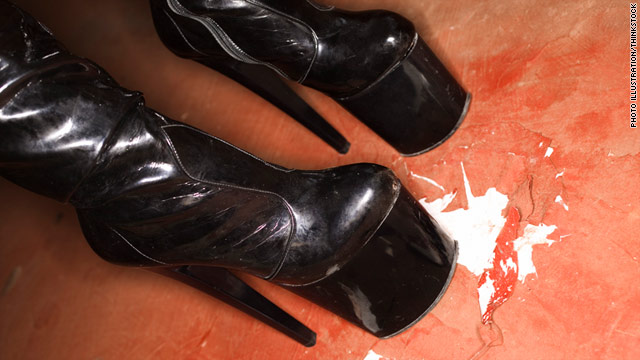

As a sexuality counselor and author, I’m often asked, “What’s the strangest thing you’ve ever dealt with?”
I wish I could tell them something really juicy, like naked clowns wrestling in Jell-O, for example, but the truth is that most sexual complaints tend to be rather common: sex ruts, mismatched libidos, erectile disorder and premature ejaculation in men, and orgasm problems and painful sex for women.
What people really want to know about are the unusual sexual fetishes of others (also known clinically as paraphilias), which affect a much smaller percentage of people.
Interestingly enough, most of those people happen to be men. That’s not to say that women lack their own unique turn-ons and turn-offs, their kinks and squicks (sexual repulsions), but when it comes to, say, having a favorite fantasy versus having an obsession in which all sexual pleasure is almost exclusively derived from a single object, body part or sex practice, more men seem to fall in the latter category.
In their compelling new book "A Billion Wicked Thoughts," (also discussed in this blog) neuroscientists Ogi Ogas, Ph.D. and Sai Gaddam, Ph.D., analyzed more than a billion Internet searches in order to learn about the differences between male and female sexual preferences, as well as what those differences tell us about how our brains are wired, and why, for example, men are more predisposed to have fetishes:
“The male sexual software is what a computer engineer would call an 'OR gate.' It is instantly aroused by any single cue. The male brain is turned on by deep décolletage or sashaying hips or the whisper of a sultry voice or two Applebee’s waitresses kissing. The female sexual brain is what a computer engineer would call an 'AND gate.' It requires input from multiple cues simultaneously to surpass a combined threshold of activation before arousal occurs. … Though for most men the OR gate can be triggered by any one of a variety of sexual cues, for some men one specific cue is essential. This necessary cue is a fetish.”
Although fetishes have been well-documented since the mid-19th century, and could easily fill an encyclopedia with thousands, if not tens of thousands, of entries (from agalmatophilia to zoophilia), the underlying mechanics of fetishes remain something of a mystery.
And while the American Psychiatry Association recognizes fetishes in its clinical bible, the "Diagnostic and Statistical Manual of Mental Disorders," there’s much professional dissent about how to treat fetishes and whether treatment can even be effective when a fetish is deeply ingrained in a person.
Freud believed (no surprise) that fetishes stem from issues such as a man’s universal fear of castration or his unconscious fear of his mother’s genitals, while many psychologists continue to believe that some sort of “sexual imprinting” must occur in the early childhood of the fetishist for sexual excitement and the fetish object to become so intricately enmeshed.
Today, fetishes are often treated with a combination of psychoanalysis (the search for deep unconscious meaning behind a fetish), cognitive behavior therapy (in which the fetishist’s thoughts are viewed as irrational ones that can be reversed with conscious mindfulness) and/or psychiatry, which seeks to alter the brain chemistry of the fetishist through drugs.
Even in our own expert-forum at Good in Bed, fetishes are a source of speculation. Recently, for example, a young woman complained of her boyfriend’s “freeze fetish” - his sexual propensity for immobility, statues and wax figures.
While her boyfriend didn’t seem to be exclusively turned on by the fetish, she nonetheless was confused and anxious. Our experts weighed in: “Fetishes don’t usually go away, but they can morph a little,” writes Dr. Madeleine Castellanos, author of "A Woman’s Guide to Men and Their Penis Problems."
“If people are disturbed by them, they could explore what the unconscious interpretation of the fetish is for them. Then they can experiment with another representation of that meaning that they can then assign erotic feelings.”
“The best way to treat fetishes is to identify the nonsexual meanings of the fetish and crack the erotic code by identifying what he is looking for unconsciously through the fetish,” adds psychotherapist Dr. Joe Kort. “Perhaps he was afraid of mannequins in retail stores or impressed with them or aroused by them as a child and now they have become part of this arousal template, or maybe he saw a movie or video about this as a child which caused it to become locked into his mind and now is eroticized. Whatever the case it could be helpful to understand the origins for both of you.”
Luckily, many people who would normally be distressed by a fetish are now finding like-minded peers via the Internet and/or some form of erotic stimulation (such as specialty porn) that caters to their specific interests.
Or they are fortunate enough to have sexual partners who, in the words of columnist Dan Savage, are sexually GGG (“good, giving and game”) and are willing to stretch their definition of the taboo and incorporate their partner’s fetish into their sex-play.
One single woman I know even joked that she’d love to meet a foot fetishist: At this point in her life, a good foot massage sounded better than sex. Perhaps the greatest goal for couples dealing with a partner who has a fetish is to decide how that fetish fits into their relationship.
“If a man is able to have healthy and hot sex with his partner and have his fetish fantasies without her and enjoy them,” asks Kort, "What’s wrong with that?”
No comments:
Post a Comment